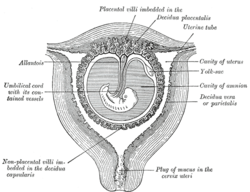Decidua
| Decidua | |
|---|---|

Diagrammatic sections of the uterine mucous membrane: A. The non-pregnant uterus. B. Decidua parietalis; the mucous membrane] in the pregnant uterus and not beneath the placenta.
|
|

Sectional plan of the gravid uterus in the third and fourth month.
|
|
| Identifiers | |
| MeSH | A16.759.289 |
| Code | TE E6.0.1.4.0.0.7 |
|
Anatomical terminology
[]
|
|
Decidua is the term for the uterine lining (endometrium) during a pregnancy, which forms the maternal part of the placenta. It is formed under the influence of progesterone and forms highly characteristic cells.
The word comes from the Latin deciduus, meaning falling off or shedding.
After ovulation, in placentalmammals, the endometrial lining becomes hypertrophic and vascular under the influence of oestrogens and progesterone.
In animals exhibiting hemochorial placentation, the endometrium then undergoes decidualization following implantation to form the decidua. If this does not occur, the secretory lining will be absorbed (estrous cycle) or shed (menstrual cycle).
The decidua is shed with the placenta during parturition.
The part of the decidua that interacts with the trophoblast is the decidua basalis (also called decidua placentalis), while the decidua capsularis, grows over the embryo on the luminal side, enclosing it into the endometrium. The remainder of the decidua is termed the decidua parietalis or decidua vera, and it will fuse with the decidua capsularis by the 4th month of gestation.
Three morphologically distinct layers of the decidua basalis can then be described:
Within the decidua, occasional fibrinoid deposits form where the syncytiotrophoblast is damaged. The region of fibrinoid deposition where trophoblasts meet the compact portion of the decidua basalis is called Rohr's layer, while the fibrinoid deposits that occur between the compact and spongy layer of the decidua basalis is termed Nitabuch's layer. This layer is absent in placenta accreta.
The decidua has a histologically-distinct appearance, displaying large polygonal decidual cells in the stroma. These are enlarged endometrial stromal cells, which resemble epithelium (and are referred to as "epithelioid").
...
Wikipedia
